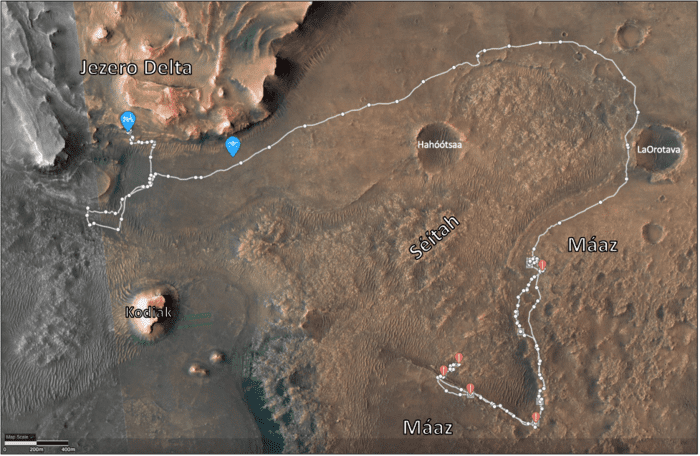NASA’s Perseverance has been working on the floor of Jezero Crater for over a year, collecting samples and analyzing the terrain. Some samples have been stored in special capsules to be sent back to Earth in the next decade – but researchers have already been able to obtain some exciting results about the rocks, with implications for the Martian past and the Red Planet’s ability to maybe host life.
Researchers have discussed these first results in the journals Science (here and here) and Science Advances (here and here). The work in the first paper focuses on the composition of the Séítah formation, one of the first intriguing targets for Perseverance. It is made of igneous rocks, mostly olivine, suggesting that they are formed by the slow cooling of a thick sheet of magma.
This idea is confirmed in the second paper, which focused on the radar observation of up to 15 meters (49 feet) below the surface. The scan of the initial three-kilometer (1.86-mile) journey reveals a layered structure below the crater floor. The observations are consistent with igneous layers altered by water over time.
Jezero crater was a lake with a river flowing into it. Perseverance is now exploring the delta of that river. By analyzing the sample here on Earth, it will be possible to date when the lake was formed as well as understand what it was like.
“From a sampling perspective, this is huge,” co-lead author of the Science paper David Shuster, professor of earth and planetary science at the University of California, Berkeley, said in a statement. “The fact that we have evidence of aqueous alteration of igneous rocks — those are the ingredients that people are very excited about, with regard to understanding environmental conditions that could potentially have supported life at some point after these rocks were formed.”
The samples in question were taken from the Séítah formation and the nearby Máaz formation, respectively the Navajo terms for “amidst the sand” and “Mars”. The rocks appeared to have formed underground and cooled slowly, and they might be from two different eruptions, so these and the many sample Perseverance is collecting will provide a detailed history of the region.
Map of where Perseverence and Ingenuity have been. Image Credit: NASA
“One great value of the igneous rocks we collected is that they will tell us about when the lake was present in Jezero. We know it was there more recently than the igneous crater floor rocks formed,” co-lead author geochemist Kenneth Farley of Caltech, added. “This will address some major questions: When was Mars’ climate conducive to lakes and rivers on the planet’s surface? And when did it change to the very cold and dry conditions we see today?”
Understanding what went on in this ancient lake is a priority objective for Perseverance. It impacts our understanding of Mars and of the early solar system in general – and there is obviously the question of life. Were the right ingredients present on Mars? Would such a lake have the right properties to turn them into a life form? Questions that are yet to receive an answer.
“These kinds of environments on Earth are places where life thrives. The goal of exploring the Jezero delta and crater is to look in these once-habitable environments for rocks that might contain evidence of ancient life,” co-author Professor Amy Williams, from the University of Florida, said in another statement.
Perseverance will continue to do its analysis and sample collection, together with its faithful companion Ingenuity, the Mars helicopter that has recently completed its 30th flight.
Source Link: Perseverance Samples Hold Key To Understanding Water-Rich Martian Past
